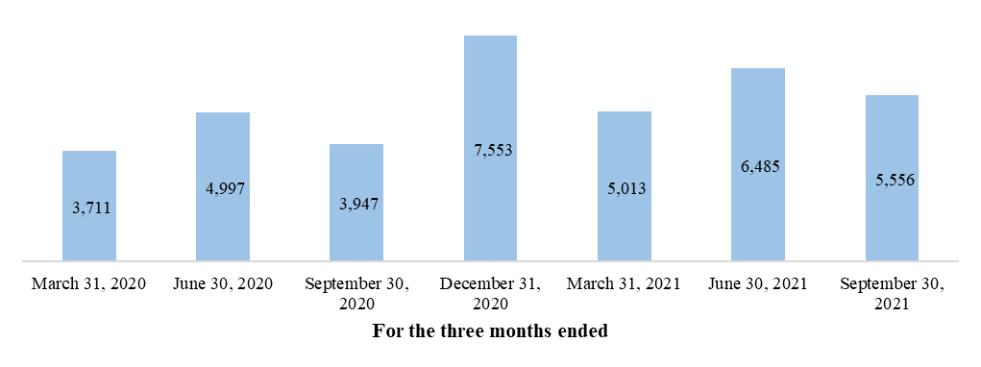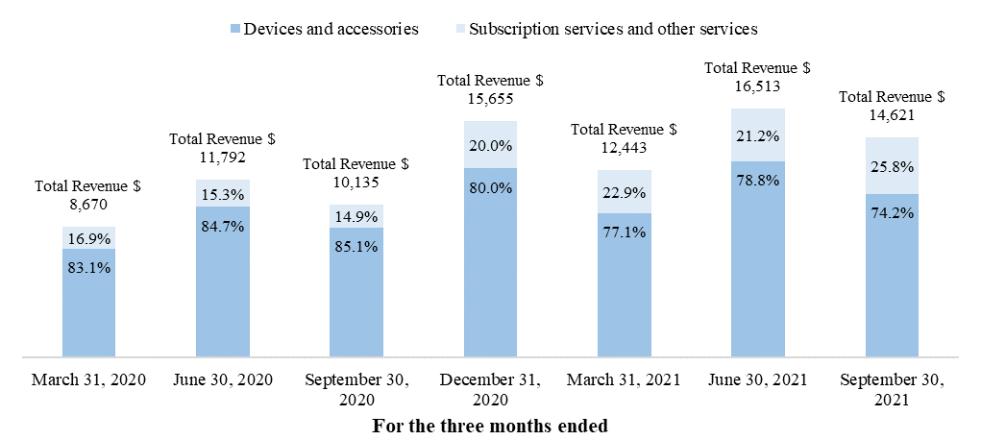one to five-year periods and may contain fixed or minimum annual commitments, subject to certain provisions that allow the Company to renegotiate the commitment. The aggregate amount of minimum inventory purchase commitments as of September 30, 2021 was $129.5 million.
During 2019, the Company entered into an inventory supply agreement with a certain third-party manufacturing vendor. In November 2020, the Company and the vendor amended the 2019 inventory supply arrangement. The amended agreement included provisions to increase the aggregate purchase commitments to $169.3 million and extend the time frame of the agreement to December 2022. The provisions of the agreement also allow the Company, once the defined cumulative purchase threshold per the agreement is reached, to pay for a portion of the subsequent inventory purchases using the vendor advance.
During the three and nine months ended September 30, 2021, the Company recognized a net loss and additional accrued liability for the vendor purchase commitment of $11.6 million. During the three and nine months ended September 30, 2021, the Company utilized $35.0 million of the accrued purchase commitment liability to reduce the value of inventory purchased under its minimum commitment in the supply arrangement. During the three and nine months ended September 30, 2020, the Company recognized a net loss on the vendor purchase commitment of $56.4 million, as an estimate of future excess inventory from its supply arrangement.
The Company applied the guidance in Topic 330, Inventory, to assess the purchase commitment and related loss. The Company considered a variety of factors and data points when determining the existence and scope of a loss for the minimum purchase commitment. The factors and data points included Company-specific forecasts which are reliant on the Company’s limited sales history, agreement-specific provisions, macroeconomic factors and market and industry trends. Determining the loss is subjective and requires significant management judgment and estimates. Future events may differ from those assumed in the Company’s assessment, and therefore the loss may change in the future.
As of September 30, 2021, the Company has a prepaid advance of $36.4 million, net of write-downs and an accrual of $19.5 million related to the agreement. The portion of the balances that is expected to be utilized in the next 12 months is included in current assets and current liabilities in the accompanying condensed consolidated balance sheets.
Other commitments:
The Company sponsors a 401(k) defined contribution plan covering all eligible U.S. employees. Contributions to the 401(k) plan are discretionary. The Company did not make any matching contributions to the 401(k) plan for the periods ended September 30, 2021 and December 31, 2020.
Contingencies
The Company is involved in litigation and legal matters from time to time, which have arisen in the normal course of business. Although the ultimate results of these matters are not currently determinable, management does not expect that they will have a material effect on the Company’s condensed consolidated balance sheets, statements of operations and comprehensive loss, or statements of cash flows.
On December 14, 2020, Nidhish Nair, a purported stockholder of Longview, filed a lawsuit in the Supreme Court of the State of New York, County of New York, captioned Nair v. Longview Acquisition Corp., against Longview and the members of its Board of Directors (the “Nair Complaint”). On December 16, 2020, Eric Lau, a purported stockholder of Longview, filed a lawsuit in the Supreme Court of the State of New York, County of New York, captioned Lau v. Longview Acquisition Corp., against Longview, the members of its Board of Directors, and Legacy Butterfly (the “Lau Complaint”). The Nair Complaint and the Lau Complaint, which are referred to collectively as the Complaints, asserted a breach of fiduciary duty claim against the individual defendants and an aiding and abetting claim against Longview in connection with the Business Combination between Longview and Legacy Butterfly. The Lau Complaint also asserted an aiding and abetting claim against Legacy Butterfly. The Complaints alleged, among other things, that (i) defendants engaged in an unfair sales process and agreed to inadequate consideration in connection with the Business Combination, and (ii) that the Registration Statement on Form S-4 filed with the SEC on November 27, 2020 in connection with the Business Combination was materially misleading. The Complaints sought, among other things, to enjoin the Business Combination, rescind the transaction or award rescissory damages to the extent it is consummated, and an award of

